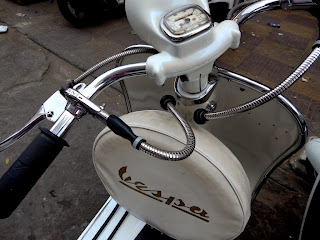10. Phnom Penh
After the first shock about the lawless and crazy traffic has resided and the motorcycle is parked in the garage, I remember again what a great Asian city Phnom Penh is. The mixture of styles, influences, food, shops, street scenes and sights is just tantalizing.
I saw the typical tourist sites many years ago and will not go again:
- Tuol Sleng, aka: S-21 (Security Prison No. 21), the former Chao Ponhea Yat High School which was turned into one of the 150 execution sites of the Khmer Rouge where more than 20,000 people lost their life;
- The Killing Fields outside of the city, near the village of Choeung Ek, where a Yale University mapping project located about 1,4 million victims of Cambodia's Democide (Theodore Abel) in the rice fields.
I do not want to visit again, the memory from many years ago is still fresh.
I stay in the city and do long walks to enjoy the many fabulous French architecture examples which fascinate me.
 |
| Sisowath Quai |
 |
| French corner architecture 1960s |
 |
| The Raffles Hotel Le Royale |
 |
| Phnom Penh Central Train Station |
 |
| Phnom Penh Central Train Station, Royal Cambodian Railway. |
 |
| Phnom Penh Central Train Station |
Seeing the architecture from the time of the French period in Phnom Penh is like travelling back in time to the France of my childhood, or to visit the rare sights of today's France where the modernistic history of the 1950-60s is not yet destroyed.
Not much travelling is going on today inside of the Royal Cambodian Railway train station, however. The beautiful interior space of the building and the platforms, built in 1932 (possibly by French architect Louis-Victor Chaucon?, not sure) and beautifully restored in 2010, was occupied by a contingent of Cambodian Riot Police in full gear, who played cards or slept in their hammocks, waiting for some order which has yet to come. I don't know the reason for their presence in the station. It might also that they are waiting to board a train. There is only one line connecting Phnom penh with Batambang in the northwest. It was originally designed to connect Cambodia with Thailand.
 |
| No chance to buy a train ticket today. |
 |
| Inside Royal Cambodian Railway Station |
The building of the Central Market (1937) in downtown Phnom Penh, designed by French architects Jean Desbois & Louis Chauchon is certainly the most iconic structure of architectural quality and that particular period. It is an airy, light-flooded dome structure made of reinforced concrete and truly adaptive to the climate. The opening patterns in the concrete shell of the roof allow for natural ventilation and create the interesting light patterns which make this collaborative "architect-engineer design" so successful.
 |
Security taking a nap.
Which reminds me: The inventor of the AK 47, the most common automatic rifle in the world today (and seen in this picture), Mikhail Timofeyevich Kalashnikov, died a few days ago December 23, 2013). |
 |
| Central Market |
The fabulous Raffles Hotel Le Royale, designed by Frenchman Erneste Hebrard in 1929, restored in 1997, is another excellent example of French tropical architecture. High ceilings and shuttered windows, together with two intimate pools in symmetrical patios create an unmistakably beautiful tropical feel and reminisce of the past colonial splendor. It is in an excellent condition, however not my accommodation in the city. Since I like to have a small kitchen to get a break from constantly eating out, I stay in a small apartment near the Mekhong river.
Here are some more views of street life in this great city.
 |
| The Great Mekhong River Race |
 |
| The Coffin shop. |
 |
| Open air barber shop |
 |
| Cable installation. |
 |
| Wired |
 |
| Central Market |
 |
| (Almost) Real Mercedes-Benz mechanics |
 |
| Chinese Noodle shop air-drying wares. |
 |
| Mekhong and Sisowath Quai |
 |
| Rice merchant |
 |
| Various types of rice |
 |
| Ready to leave for the trip to the provinces: The infamous mini-bus. |
Today I close with a few images of a beautifully restored Vespa, owned by a young lad in a mobile phone shop (everybody is young here), a motorcycle with crutches, and the shoe repairman fixing my off-road knee-guards. Very good job! Thank you!
Tomorrow I will explore more examples of French architecture between the 1920s and 1960.
 |
| My off-road knee-guards get a needed make-over. |











































No comments:
Post a Comment